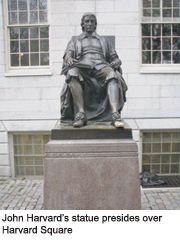In 1893, Baedeker’s guidebook described Harvard University as “the oldest, richest, and most famous American seat of learning”. All three descriptions of this vintage and venerated university have endured, even as its fame and reputation has spread worldwide. Harvard has been ranked first among the world’s most respected universities every time since the Times Higher Education-QS World University Rankings were initiated in 2004, and among the top three national universities in the U.S. News & World Report’s annual ranking of America’s Best Colleges since the survey began in 1983.
The steady growth and development of the autonomous Harvard University, which has a current enrolment of 6,700 undergraduate students from 109 countries around the world, and its ten research-intensive postgrad schools (Harvard Business School, Harvard Medical School, Harvard Law School, School of Divinity etc.) which together host 12,300 students, provides an excellent institution development model for the growing number of private or ‘deemed’ universities in India to emulate.
Founded in 1636 — 16 years after America’s ‘pilgrim fathers’ fleeing religious persecution in England, landed in Plymouth, New England — for educating Protestant clergy, Harvard has built itself an awesome reputation over the past four centuries, educating eight American presidents from John Adams to Barack Obama and nurturing more than 40 Nobel Prize winners.
 Named after its first benefactor, John Harvard (1607-1638), a young minister who bequeathed his library and half his £1,600 (Rs.1.05 lakh) estate to the new institution, Harvard’s first scholarship fund was created in 1643 with a gift from Ann Radcliffe, Lady Mowlson. The then nascent college offered classic academic programmes modelled upon England’s ancient Oxford and Cambridge universities, whom it has since surpassed in global fame and reputation.
Named after its first benefactor, John Harvard (1607-1638), a young minister who bequeathed his library and half his £1,600 (Rs.1.05 lakh) estate to the new institution, Harvard’s first scholarship fund was created in 1643 with a gift from Ann Radcliffe, Lady Mowlson. The then nascent college offered classic academic programmes modelled upon England’s ancient Oxford and Cambridge universities, whom it has since surpassed in global fame and reputation.
The growth and development of Harvard College into the wholly autonomous Harvard University has been engineered by its several great presidents or chief executives. Among them: John Leverett, the college’s first non-clergy president, who during his term (1708-1724) transformed the character of Harvard from a quasi-religious college into an intellectual institution driven by a spirit of scholarship and enquiry. Leverett’s mission to transform Harvard College into a fully-fledged university based on the Oxbridge model was continued by presidents Edward Holyoke (1737-1769), John Willard (1781-1804), Samuel Webber (1806-1810), John Thornton Kirkland (1810-1828) and Josiah Qunicy (1829-1845).
Harvard College officially transformed into Harvard University under the highly acclaimed presidency of Charles W. Eliot (1869-1909). During his long tenure, Eliot radically transformed Harvard into a modern research-driven university. Under Eliot’s watch, women were admitted for the first time into a Harvard Annex for women’s instruction in 1879. By 1894, the annex was chartered by the Commonwealth of Massachusetts as Radcliffe College. Separate admissions for men and women ended in 1977, and in 1999, Radcliffe College formally merged with Harvard University, and is now known as the Radcliffe Institute for Advanced Study.
Eliot was succeeded by A. Lawrence Lowell (1909-1933) under whose supervision the undergraduate course of study was redesigned to provide students with a liberal education preceding concentration in a single field. Today 51 fields of concentration are offered by Harvard College.
The university is known as much for its scholarship and research as for its massive endowment corpus (currently valued at $28 billion or Rs.140,000 crore) and fund-raising capability. From 1953-1971, under the presidency of Nathan Pusey, Harvard undertook what was then the largest fundraising campaign in the history of American higher education, an $82.5 million (Rs.412 crore) fund-raising programme for Harvard College.
A similar campaign was initiated by president Derek Bok (1971-1991), to raise over $365 million (Rs.1,825 crore) by the end of 1984. A decade later, Lawrence H. Summers (2001-2006) began the monumental Allston Initiative, a project for developing over 200 acres of Harvard land in the Allston section of Boston at a project cost of $1 billion (Rs.5,000 crore).
Currently the director of the National Economic Council in the incumbent Obama administration, Summers is also famous for introducing the Harvard Financial Aid Initiative, 2004, under which admitted students from families with annual incomes of less than $80,000 are exempt from paying for tuition, room, and board. However in 2006 Summers was obliged to resign his office following some comments in which he speculated that women could have less aptitude for math and science careers.
Summers was succeeded by Dr. Drew Gilpin Faust, professor of history at the Radcliffe Institute. Harvard’s first female president, Faust has maintained its history of securing robust endowments. Last year, the university received the largest single endowment from one source in its history, when Swiss billionaire Hansjorg Wyss donated $125 million (Rs.625 crore) to the Harvard University corpus to found the multi-disciplinary Hansjorg Wyss Institute for nanotechnological development, stem cell research, bioengineering, and molecular biology, at the Harvard Medical School.